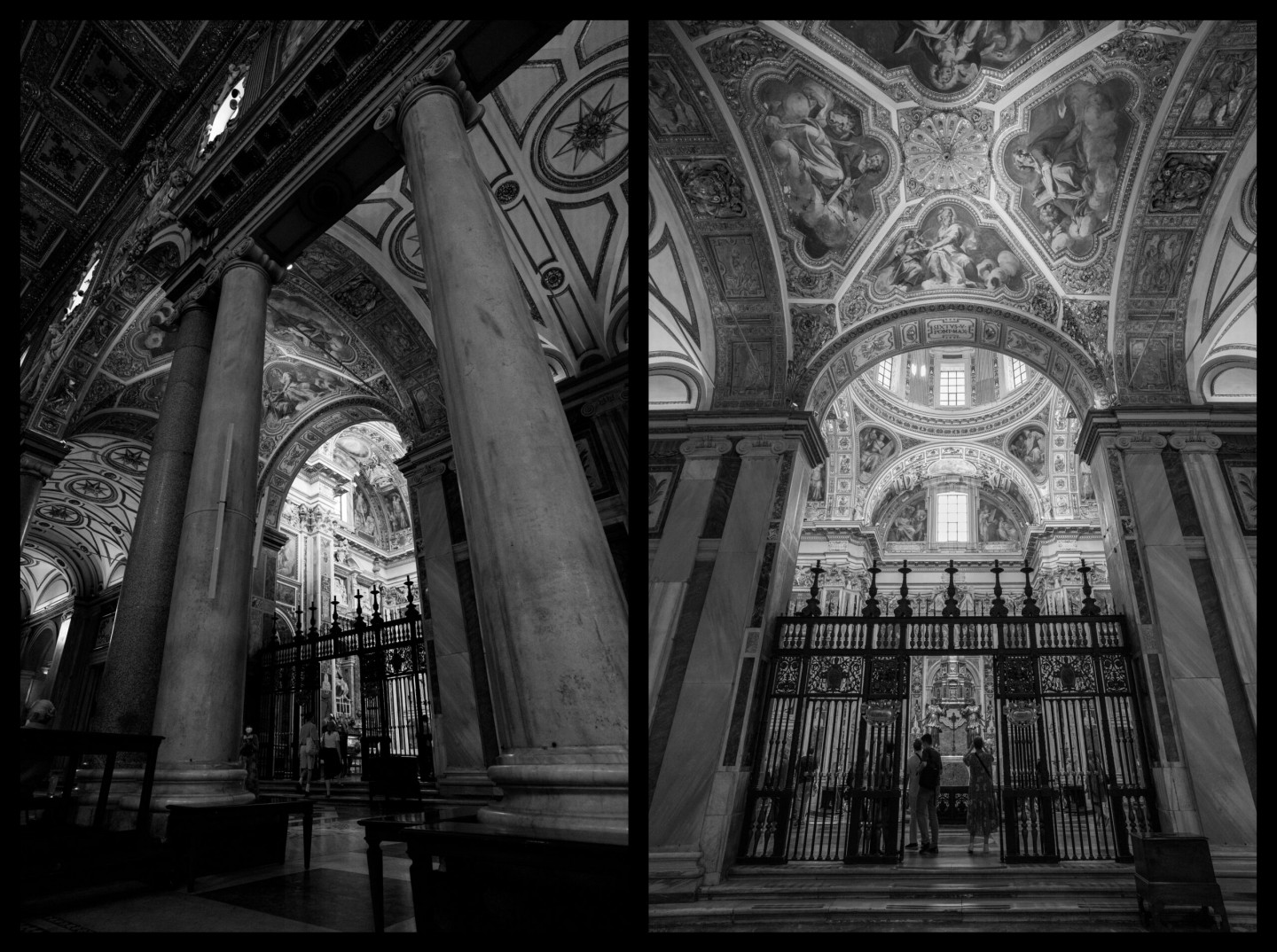Ezt a bejegyzést egy vallomással kell kezdjem: az utolsó kép a címtől és a többitől eltérően 2021-ben készült és egy APSC-vázon, 35 mm-es objektívvel. Erre a kivételre viszont mégis szükségem volt. 2021. novemberében jártam egyik este a templomban úgy, hogy a Capella Sistinában (nem összetévesztendő a vatikáni azonos nevű kápolnával) épp zajlott a liturgia. Ekkor kezdett el igazán mozgatni az ókeresztény gyökerekkel rendelkező főtér kereszttengelyében álló későbbi bővítés.
Ne felejtsük, figyelemre méltó a háromhajós bazilikáris hosszház is, különös tekintettel az 5. és 13. századi mozaikokra. Ennek ellenére a mostani látogatásomnál talán már tudat alatt is eltérített a kereszttengelyben felépített, Domenico Fontana által tervezett késő-reneszánsz mellékkápolna. A két melléktér belmagassága jelentősen nagyobb a főhajóénál (ez a templomot körbesétálva is teljesen egyértelmű), emellett a kupolás teret erősebb természetes megvilágítása is kiemeli (borítókép). Az eredeti térszerkesztéshez képest a kereszttengely mindenképp nagyobb hangsúlyt kap, de a térhatás mindenképp különleges. Ahogy korok, szerkesztési rendszerek, különböző irányítottságú terek, eltérő fényviszonyok találkoznak.
Azóta többször gondolkodtam ezen a térkapcsolaton. Volt, hogy túlzónak éreztem. De jobban visszagondolva egyáltalán nem az. A térkapcsolat nem túl direkt, sőt a belső térben szinte az utolsó pillanatig nem is lehet látni a teret és a kezdeti betekintés is visszafogott. Így próbáltam visszaemlékezni a novemberi látogatásra: ekkor egyenesen a főoltár irányába mentem először és csak visszafelé figyeltem fel a Capella Sistinában zajló liturgiára, majd a térre. Ez aztán elgondolkodtatott azon, hogy az emlékeink és élményeink néha mennyire képesek még az amúgy objektívnek tűnő térérzékelésünket is befolyásolni…
Photographs: Balázs Bodó - ALL RIGHTS RESERVED. (20mm ISO3200 F5.6 1/50-1/80; APSC 35mm ISO800 F1.8 1/50)
First I have a confession to make: the last photo, contrary to the title and unlike all the others, was taken in 2021 and on an APSC body with a 35mm lens. However, I felt this exception is neccesary. One evening in November 2021, I visited the church while a liturgy was taking place in the Capella Sistina (not to be confused with the Vatican chapel of the same name). This was the point when I started to get interested in this transverse axis expansion of the basilica with early Christian roots.
Do not forget, that the three-nave basilica is also noteworthy, especially the 5th and 13th century mosaics. Nevertheless, on my current visit, the late-renaissance side chapel designed by Domenico Fontana, distracted me. The interior height of the two side spaces is significantly higher than that of the main nave (this is quite clear when walking around the church), and the domed space is also highlighted by the stronger natural light (cover image). Compared to the original spatial design, the transverse axis is definitely given more emphasis, but the spatial effect is definitely impressive. As ages, construction systems, spaces with different orientations, different lighting conditions meet.
Since then, I have thought about this spatial relationship several times. Sometimes I felt it exaggerated. But on second thought, I changed my mind. The spatial connection is not very direct, in fact it is not possible to see the space in the interior almost until the last moment and the initial insight is quite restrained. So I tried to recall my previous visit in November: then I went straight in the direction of the main altar first, only noticed the liturgy in the Capella Sistina going backwards and grasped the vastness of the space last. This, then, made me wonder how our memories and experiences can sometimes affect even our seemingly objective perception of space…
